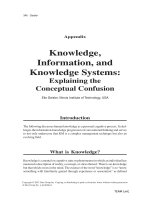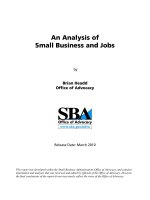Knowledge Cities Approaches Experiences and Perspectives by Edna Pasher_7 potx
Bạn đang xem bản rút gọn của tài liệu. Xem và tải ngay bản đầy đủ của tài liệu tại đây (574.02 KB, 27 trang )
Artefact Relationships—a file that identifies and links the arte-
facts that were drawn upon in some way to create the current
artefact, artefacts that refer to the current artefact, and artefacts
that were reused in some way to fashion the current artefact.
Artefact Network Maps
As with the organizational network maps above, the Knetmap
TM
methodology facilitates the creation of Artefact Network Maps,
which can be analyzed to reveal:
Contributors to the organizational knowledge base
Artefacts that have a significant influence on the organization
Product/process experts
Areas of primary knowledge development in the organization
Areas of innovation in the organization
Strategic initiatives that are at the forefront of the organiza-
tional mind
Communities of practice or communities of interest.
The benefits of creating such a map include:
Directing the organization to explicit knowledge that should be
shared and accessed more broadly
Using organizational expertise more effectively
Exposing employees’ expertise and contributions to one
another
Providing deeper meaning through making connections
between artefacts
Encouraging innovation
Documenting relevant knowledge.
Systems: Generating Capabilities 171
ch09.qxd 3/19/04 4:01 PM Page 171
Knowledge Maps and Conventional
Organizational Charts
With knowledge flows mapped and artefacts identified and contin-
ually created, knowledge maps illustrate the way work is really done
within the organization. Flow mapping and artefact identification
give a richer and more meaningful view of organizational dynamics
than can be gleaned from a conventional organizational chart, which
does not allow employees to see their ability to contribute to the
organization as a whole. Moreover, organizational charts give no
insight into the functioning of the team-based and cross-functional
relationships that are the real drivers of innovation and competitive
advantage in the knowledge era.
Knowledge Access and Learning
The second component of the knowledge architecture for the
systems that generate capabilities is knowledge access. While learn-
ing (the process of turning information into knowledge for effective
action) is also supported by knowledge exchange, we’ll focus on how
knowledge access, especially in the form of e-learning, enables this
key capability generation system.
Learning takes place at four levels: individual, team, organiza-
tional, and customer, which, much like Russian matruschka dolls,
are contained inside one another (see Figure 9.5). Learning at the
individual level is found at the team level, which in turn is found at
the organization level, which is found at the customer level. The
individual level, the innermost kernel, is at the heart of the organi-
zation’s ability to learn. In other words, a predisposition to learning
on the part of individuals is a necessary condition for learning at the
other levels.
For the conductive organization, continuous learning externally at
the customer interface and internally across the organization begins
with shaping the culture and creating the structural foundation so
that an individual employee is ready, willing, and able to learn.
172 The Conductive Organization
ch09.qxd 3/19/04 4:01 PM Page 172
Learning and Work
A highly conductive organization creates an environment where
learning is not just encouraged but perceived as virtually indistin-
guishable from working. The integration of work and learning is
necessary because of the speed at which markets change. It’s unre-
alistic for work and learning to travel separate trajectories or be seen
as exclusive processes. If organizations are to be successful, the rate
of learning must equal or exceed the rate at which markets change.
Learning, at all levels, must be recognized as so crucial to sus-
tainable success that it becomes the organization’s heartbeat. Arm-
strong’s purpose statement is supported by two values that focus on
generating capabilities: learning and innovation. Learning is also at
the heart of Clarica’s organizational structure, as shown in the fol-
lowing example.
Real-Time Learning at Clarica
Clarica created a multiwindow information system built to support
customer service representatives in the organization’s call center.
When a customer calls, the service representative has a list of all the
solutions purchased from the organization by this customer, details
Systems: Generating Capabilities 173
Customer Learning
Organization Learning
Team Learning
Individual
Learning
Figure 9.5 Levels of Learning
ch09.qxd 3/19/04 4:01 PM Page 173
on their most recent transactions, the issues that were encountered,
and how they were resolved. The full history of that customer is at
the employee’s fingertips.
Another window has the answers to any inquiry the customer
might have.As customers ask their questions, the representatives can
zero in on the corresponding logic trail and provide the best answer
the organization can offer. Instead of training customer service
representatives for months, Clarica enables representatives’ self-
initiated learning while interacting with the customer.
This example shows how real-time learning can help the employee
work with the customer to find the right solution for that customer
rather than offering the customer a standard set of answers about
product offerings. It’s also an example of how learning can be fully
integrated with work. It’s difficult to distinguish which part of this
example should be characterized as work and which as learning.
Learning Purposes
Learning in a work context has two key purposes: enhancing and
reframing. Enhancing is fine-tuning, deepening, and broadening
capabilities within a given context and acquiring methods and rules
for dealing with known and recurring situations. Enhancing con-
tinually improves existing systems and existing patterns of behavior
and is essentially achieved through the harvesting of explicit knowl-
edge. Reframing is the renewal of assumptions and beliefs to corre-
spond more closely to the evolving reality of the marketplace and
reinventing methods and approaches for dealing with new situations
and challenges. Reframing leads to the development of new systems
and patterns of behavior and is essentially achieved through the har-
vesting of tacit knowledge.
Self-Initiation
The first condition for effective learning is self-initiation. To guide
decisions about the learning context, we’ve identified six principles:
174 The Conductive Organization
ch09.qxd 3/19/04 4:01 PM Page 174
Learning is an employee expectation—every employee has the
right to learn.
Employees are responsible for their learning and for sharing
their learning.
Learning is integral to continuously improved business
outcomes.
Learning is best applied in the course of doing work.
Technology should provide equitable access to learning oppor-
tunities as needed by the employee.
Employees require opportunities to share and learn in groups.
As we can see, individual learning is the right of the individual, but
employees are responsible for making sure learning happens and for
sharing it organization-wide. Moreover, the organization must
ensure that the conditions are right for learning to take place so that
employees can access opportunities to increase their skills and
knowledge as the need arises.
Learning Versus Training
Where self-initiation exists it’s possible to replace traditional train-
ing approaches with alternative approaches. Enabling greater learn-
ing by eliminating a focus on training may seem paradoxical at a
time when there is a growing need for knowledgeable employees.
But traditional training approaches are increasingly found wanting
as organizations attempt to keep pace with market demands. Train-
ing, which is usually delivered through classroom approaches out of
the context of the work environment, cannot meet the just-in-time
demand of a highly conductive organization.
With an instructor in control of the schedule, location, and
content; the student a passive receiver of information out of context;
and the experience counter to the culture and core values of the
organization, there’s little chance that capabilities can be generated.
To deal successfully with customers in the knowledge era, we
must, more than ever before, have the necessary knowledge at our
Systems: Generating Capabilities 175
ch09.qxd 3/19/04 4:01 PM Page 175
fingertips at all times. The capabilities of employees interacting with
the customer must constantly be renewed and enhanced to meet
ever-increasing customer requirements. Traditional training cannot
begin to cope with the learning needs of people relating directly to
customers.
In a learning as opposed to a training mode, we’re operating not
on the basis of the preparation and delivery of courses, but rather
on creating a work environment in which employees can increase
the specific competencies needed to perform their jobs (see Table
9.2).
e-Learning
With the principle of self-initiated learning established and the par-
allel paradigm shift from training to learning, it’s critical to ensure
that the infrastructure is in place to enable real-time, on-the-job
learning. Leveraging web-enabled technologies and utilizating e-
learning tools enable more effective learning. e-Learning is a net-
worked approach to learning that is equally applicable to knowledge
exchange and knowledge access.
176 The Conductive Organization
Table 9.2 Distinctions between Training and Learning
Training Learning
Prescriptive approach Self-initiated approach
Led by instructor (push) Self-directed (pull)
Mostly classroom-based Multiple delivery
Delivering programs as an end Increasing capability as an end
Participation is the only Demonstration of capability is the key
measurement measurement
Offered as one size fits all Targets only the gap between required and
current capability
Based on generic training needs Based on individual competency assessments
analysis
ch09.qxd 3/19/04 4:01 PM Page 176
e-Learning should not be confused with e-training. All too often
organizations automate their training and believe they are offering
e-learning. As with traditional training and learning modes, the dis-
tinction between e-training and e-learning has to do with the deliv-
ery of knowledge—whether it is delivered via a push mode or a pull
mode. The former is e-training, the latter is e-learning.
Web-Based Technologies
The proliferation of ways to connect with people and information
is redefining how society and individuals behave, producing pro-
found implications for how we organize, manage, lead, and elevate
the performance of our organizations. Almost without exception,
organizations today take advantage of web-enabled capabilities to
share information. In a relatively short time, intranets have become
an expected part of an organization’s infrastructure. But intranets
have been underutilized as real-time learning tools and as knowl-
edge repositories. For the most part, intranets have become vast
wastelands of static information.
Knowledge Depots
Clarica labelled its intranet Clarica Connects to emphasis access to
tacit and explicit knowledge. Through the home page, employees
could access information about business services, news, people ser-
vices—even the cafeteria menu. It also included a Knowledge Depot
that housed corporate policies and procedures, reference resources,
and learning opportunities. It integrated work and learning
resources in one place. The design made it possible to access infor-
mation by resource type (e.g., a community of practice, course,
learning module, policy, process, or procedure) or to enter a search
string and view a list of all work-related information and learning
opportunities within the organization as well as useful external links
and references pertinent to that subject.
Systems: Generating Capabilities 177
ch09.qxd 3/19/04 4:01 PM Page 177
Knowledge Objects
From a learning perspective, when employees found knowledge they
wished to explore, they could acquire knowledge by accessing units
of knowledge, called knowledge objects—discrete units of knowledge
that could be used on their own or assembled to create a more com-
prehensive resource. Working at the object level, it was easier to inte-
grate quick references to support queries related to employee
learning needs.
Learning centers were developed to automatically assemble
knowledge objects to meet varying levels of learner needs on a par-
ticular subject—quick tips, brief overviews, learning modules, full
courses, and links to experts and communities.
In the Leadership Learning Center, employees could search for
learning opportunities and knowledge objects to develop their capa-
bilities. For example, if someone had to provide feedback to a col-
league and was unsure how to do it in the most constructive manner,
the Leadership Learning Center could be accessed and searched
under the phrase “giving feedback.” A list of relevant resources was
dynamically assembled, including: tips, links to policies, modules
and courses on constructive performance feedback, and links to
experts available to coach the employee on the specific situation.
Organization-Wide e-Learning
In the late 1990s Clarica purchased a large pension business from a
bank and had to integrate the business into Clarica operations.
Pension plans tend to be complex, so a conventional training
approach would have required new employees to spend up to three
months in the classroom to learn about Clarica’s plans and plat-
forms. This training would have been time-consuming and costly,
and the delay in service frustrating to customers in the interim.
By deploying a knowledge-sharing system available at the
desktop, a customer service representative servicing pension cus-
tomers was able to ask a question relating to the pension process.
178 The Conductive Organization
ch09.qxd 3/19/04 4:01 PM Page 178
The question was either answered through an archived response or
forwarded to an internal expert who handled that particular part of
the plan. The expert’s answer was supplied to the employee and then
captured and archived to provide an automated response to a future
enquiry.
Rather than employees’ spending three months in a classroom
being overloaded with information, most of which they either
wouldn’t retain or wouldn’t ever use, this system provided the just-
in-time learning that employees need.
Career Development
With a new employment contract that gives individuals the right
and responsibility to develop their own capabilities, it’s vital for
organizations to ensure that employees have access to the best pos-
sible e-learning tools for capability and career development. At
Clarica, all employees had their own I-Connect sections within the
Clarica Connects portal that allowed them to manage their own
capability and career development plans. I-Connect included a
number of components:
Achievement Management: Learn about achievement man-
agement. Create individual achievement plans and share the
plans online with the employee’s manager.
Learning and Development: Access information and learn
skills to assist with day-to-day work.
Career Management: A complete framework for career man-
agement, from self-assessment to career options, effective job-
search techniques, and job offer negotiations.
Career management provided employees with the ability to under-
stand their work situation and create winning career strategies that
align with their skills, desires, goals, and values and included per-
sonalized sections to assess: my fit with job opportunities, research-
ing my career options, and taking action. It also included a
Systems: Generating Capabilities 179
ch09.qxd 3/19/04 4:02 PM Page 179
self-management system that allowed employees to work through
modules in areas such as: self-confidence, self-direction, and self-
commitment. The self-confidence modules examined managing
self-criticism, managing confidence through behavior, managing
external criticism, managing change, and managing complacency.
Although we stress the importance of self-initiated learning, it’s
the organization’s responsibility to make learning possible as a seam-
less, integrated process with work.
Conclusion
Systems to generate capabilities in the conductive organization must
be fully aligned with the strategy, culture, and structures that
support learning and collaborating that are seamlessly integrated
with work. Industrial-era training can no longer meet the just-in-
time need to generate capabilities at the speed that the market
demands.
To fully leverage capability generation, the knowledge and learn-
ing system must be based on a comprehensive knowledge architec-
ture that provides a blueprint for how knowledge can be accessed
and exchanged from anywhere, but most importantly from the
employee’s desktop.
Knowledge and learning are at the core of capability generation.
Tapping individual tacit knowledge and the collective explicit
knowledge puts the wealth of an organization’s most valuable asset
in the hands of its employees and customers to create breakthrough
performance.
180 The Conductive Organization
Emerging Principles
Knowledge is the capability to take effective action.
Learning is the process of turning information into knowledge to
take effective action.
ch09.qxd 3/19/04 4:02 PM Page 180
References
1. Saint-Onge, H. and D. Wallace. (2003). Leveraging Communities
of Practice for Strategic Advantage. Boston: Butterworth-
Heinemann.
2. Wasserman, S. and K. Faoust. (1994). Social Network Analysis,
Methods and Applications. Cambridge: Cambridge University
Press.
Systems: Generating Capabilities 181
The systematic management of knowledge is fast becoming a
strategic capability.
Employees must assume responsibility for knowledge exchange as
a key part of their learning and capability development—as part of
the way they do their work.
The rate of learning must equal or exceed the rate at which the
marketplace changes.
Enhancing learning continually improves existing systems and exist-
ing patterns of behavior.
The first condition for effective learning is self-initiation.
E-training is a push mode; e-learning is a pull mode.
Knowledge and learning are at the core of capability
generation.
ch09.qxd 3/19/04 4:02 PM Page 181
This page intentionally left blank
10
A New Leadership Agenda for the
Conductive Organization
183
Introduction
Leadership sits at the center of the organizational capability model
for the conductive organization (see Figure 10.1). It triggers the
dynamic tensions needed to keep the four key organizational capa-
bilities calibrated to the customer. It synchronizes strategy, systems,
structure, and culture—keeps them evolving to meet changing
customer requirements. Leadership determines the bandwidth of
knowledge flow, providing a catalyst for others to exercise their
responsibilities, encouraging self-initiation, trust, interdependence,
and partnering across the organization.
We define leadership as the manner in which individuals choose
to exercise their responsibilities. We purposely use individuals
and not managers because we see leadership as a capability that
must be encouraged and nurtured within all employees, not just the
few who sit at the top of the organizational chart. However, we also
recognize that employees have varying degrees of leadership
accountabilities. While everyone in the organization is encouraged
to exercise their leadership capabilities in appropriate ways as
dictated by customer needs, leadership at the senior and manager-
ial levels has added accountabilities to set direction, manage
performance, and make decisions that affect the dynamics of the
organization.
ch10.qxd 3/19/04 4:10 PM Page 183
Leadership is an organizational capability. While individuals
develop capabilities to better exercise their leadership, the organiza-
tion creates the context for leadership. A person with highly devel-
oped leadership skills cannot exercise his or her leadership to its
fullest in a nonsupportive context.
The leadership agenda outlined in this chapter is generic—applic-
able across industries, sectors, and corporate sizes. Although size
affects some of the dynamics of leadership, the same fundamental
issues remain for an organization of 500 or 50,000 people.
Leadership in the Industrial and Knowledge Eras
The leadership challenge today presents an exciting opportunity to
transition organizational models from industrial-era to knowledge-
era configurations. Testing new models and approaches is necessary
to find an effective combination that will build a highly conductive
organization. It’s next to impossible to lead knowledge-era organi-
184 The Conductive Organization
Leadership
M
a
r
k
e
t
p
l
a
c
e
E
n
v
i
r
o
n
m
e
n
t
C
u
s
t
o
m
e
r
S
t
r
u
c
t
u
r
e
S
y
s
t
e
m
s
S
t
r
a
t
e
g
y
C
u
l
t
u
r
e
Figure 10.1 Leadership—A Core Organizational Capability
ch10.qxd 3/19/04 4:10 PM Page 184
zations with industrial-era structures and approaches. The differ-
ences in customer expectations alone are monumental.
In the industrial era, managers led through strict command
and control structures. They were rewarded and promoted on
the basis of their judicious allocation of scarce financial capital.
The collective role of leadership was to successfully facilitate
the process from making the product to selling it to customers.
It was an inwardly focused leadership approach. Managers were
not necessarily required to be customer-focused, and eliciting
the commitment of their direct reports was far less important
than making sure that their employees completed their narrowly
defined tasks. This approach was the norm for almost two hundred
years.
Working with organizations transitioning from industrial-era to
knowledge-era paradigms, we’ve observed that successful leadership
operates not through an internal pyramid but through the assem-
bly, disassembly, and reassembly of cross-disciplinary teams, which
may also include customers and/or partners. Leaders are able to
foster an environment of learning, trust, and collaboration in which
values-based relationships are built with customers and employees
are committed to the organization’s vision. To accomplish these
goals, we need a new leadership agenda—new forms of leadership
mindsets, values, and competencies.
Organizations today are based on radically different assumptions
than were historically used (see Table 10.1). These changes in focus
have resulted in new meaning for the leadership agenda (see Table
10.2).
As these tables illustrate, the required leadership approaches today
are conceptually and practically far removed from much we’ve seen
before. A key difference is that knowledge-era organizational
assumptions start with the customer and challenge the leadership
dynamic to constantly calibrate the organizational capabilities to
customer needs.
A New Leadership Agenda 185
ch10.qxd 3/19/04 4:10 PM Page 185
A New Model of Leadership
Starting with customers and working back toward the organiza-
tion—an outside-in perspective—means new challenges for the
leadership agenda. To summarize the sequence:
In the knowledge era success begins by defining the relation-
ship that the organization wishes to develop with customers
and the relationship that customers wish to develop with the
organization.
Based on this customer focus is a need to identify and nur-
ture the type of culture that will deliver to this customer
relationship.
Culture becomes an organizational capability by describing
and living a set of shared or core values that are also aligned to
the values of the customer.
Articulate the type of leadership capability that is required to
engender a values-based, customer-calibrated culture—with
186 The Conductive Organization
Industrial Era Assumptiomns Knowledge Era Assumptions
Production/ Product/ Marketing Customer Customer Team Resources Solutions
Resource Services
Divide and subdivide work for greater Cluster capabilities in cross-disciplinary
efficiency teams
Prosper by focusing on one’s own interests Complement one’s own values and
in a win-lose competitive context capabilities with those of others in a
win-win context both within and
between companies
Create value by transforming raw matter Create value by building on ideas,
into finished goods including those of customers and uppliers
Optimize capital assets by managing Leverage both capital and knowledge
associated costs assets
Lead through hierarchical command and Lead by fostering values and a culture
control approach based on interdependence
Table 10.1 Industrial-Era and Knowledge-Era Organizational Assumptions
ch10.qxd 3/19/04 4:10 PM Page 186
emphasis on self-initiation, trust, interdependence, and part-
nering characteristics.
A New Leadership Agenda 187
Industrial Era Leadership Knowledge Era Leadership
Approaches Approaches
Compartmentalize functions and Minimize “organizational walls” in order to
tasks in a command and control optimize the ability to exploit rapidly and
context unpredictably changing market
opportunities
Provide quick access to total skills base of
the organization
Establish lines of control through Manage accountabilities through a shared
hierarchical structures sense of responsibility
Enable team/re-team to provide the
routine reconfiguration of resources
dedicated to a particular customer’s needs
Define closely supervised rules Purposefully generate knowledge and
and procedures to limit freedom expertise
of manoeuvre in order to ensure Reward value-adding contribution through
performance standards teams
Table 10.2 Leadership Approaches in the Industrial and Knowledge Eras
Given that we view leadership as an organizational capability as
much as the competence of any one person, we believe that leader-
ship must become a core competence of the organization, a critical
component of its structural capital. The leadership capabilities we
describe serve as both required attributes of corporate leaders and
descriptors of what may help organizations assume a leadership
position in their industries. The capabilities can be seen as much as
descriptors of the conductive organization as of an individual exer-
cising his or her leadership.
We’ve identified five capabilities that we’ve found useful in build-
ing a leadership profile needed in the knowledge era. The profile
outlines an ideal, an aspirational level that we can work toward. Very
few individuals will embody all of these attributes. The challenge is
ch10.qxd 3/19/04 4:10 PM Page 187
to begin building these capabilities at all levels of the organization
and ensure that, at senior leadership levels, a team collectively pos-
sesses these characteristics.
The core leadership capabilities required in a highly conductive
organization include: detecting patterns, responding with speed,
creating partnerships, generating capability, and infusing meaning
(see Figure 10.2). Note that infusing meaning sits at the center of
the model. Like leadership’s position in the model of key organiza-
tional capabilities, infusing meaning enables a leader to orchestrate
and effectively deploy the other four capabilities.
Detecting Patterns
To detect patterns, people need to:
Understand the dynamics of the marketplace
Isolate and interpret trends
Assess the response patterns of the organization
Track the expectation/capability ratio.
We know that markets shift rapidly today, and that customers are
demanding more value-added components in their relationships
188 The Conductive Organization
Detecting Patterns
Responding with Speed
Infusing Meaning
Creating partnerships
Generating Capability
Figure 10.2 Leadership Capability Model
ch10.qxd 3/19/04 4:10 PM Page 188
with suppliers. Detecting patterns requires a sense-and-respond
mindset across the organization. Sensing and responding may be
achieved through something as complex in practice as the unfiltered
mindsets approach adopted by Mayekawa Manufacturing or some-
thing as simple as the following approach used by a fast-food chain
in Tennessee:
At Pal’s Sudden Service, winner of a Malcolm Baldrige National Quality
Award in 2001, leadership team members must knock on doors within the
vicinity of their restaurants, seeking direct input on customer satisfaction
and preferences. The introduction of flavored drinks was one innovation
resulting from this practice. As for financial payback, in 2001 when com-
petitors had flat revenues, Pal’s increased sales by 21% without price
increases. (2)
The leadership team at Pal’s Sudden Service not only required
good communication skills and an ability to represent their brand
promise to customers, they required the analytical skills to under-
stand the implications of what was happening in their markets—
they needed to be able to recognize patterns and then have the
courage to make strategic decisions based on their analysis and
insights.
If leaders cannot perceive the business environment accurately
and cannot respond accordingly, they will risk the danger of moving
at the last minute and making decisions that are inspired by panic,
increasing the likelihood of strategic failure.
Responding with Speed
To respond to market forces in a timely manner requires:
Compressing timeframes for decision-making/execution
Instilling a collective sense of urgency
Configuring and reconfiguring capabilities and business
processes
Sharing information quickly and openly.
A New Leadership Agenda 189
ch10.qxd 3/19/04 4:10 PM Page 189
With most markets today propelled at warp speed, it’s incumbent
on organizations to ensure that the rate of decision making and
implementation are equally rapid. Clearly, protracted decision
making processes negate any notion of speed. To become highly con-
ductive, an organization must remove unnecessary barriers to deci-
sion-making and make valid information available to enable people
to make accurate assumptions. Conductivity has both quality and
transmission components—leaders must ensure that the high-
quality information is available and accessible.
A shared vision reduces the time frame of achieving goals. At
Armstrong, our shared vision is outlined in our purpose statement:
We are committed to developing and facilitating new capabilities for our
worldwide customers and ourselves.
This shared vision creates a common understanding about what the
organization is trying to achieve. It provides a laser focus for our
decision-making process.
Supporting this vision is alignment to core values, the criteria
for all decisions, actions, and behaviors. For example, Armstrong
has a value focused on learning and innovating with customers.
Any idea or suggestion that may create capabilities through inno-
vating with customers will be approved without lengthy debate and
can be initiated at any level without going through management
hierarchy.
The ability to configure and reconfigure business processes and
capabilities, to continually calibrate to the customer, is central to the
leadership agenda today. It requires that the leadership team under-
stands the big picture of how their organization is working in rela-
tion to the customer needs, an ability to orchestrate high-level
changes to business processes, and an ability see where new or
evolved capabilities are required. At the operational level, an under-
standing of how capabilities can best be configured for specific pro-
jects and an ability to ensure that project teams work cohesively are
required.
190 The Conductive Organization
ch10.qxd 3/19/04 4:10 PM Page 190
Creating Partnerships
The ability to create partnerships includes:
Interacting intensively with customers to craft opportunities
Building alliances and coalitions in the marketplace
Forming and reforming teams across functions and with
customers
Collaborating to actively manage interdependencies.
The capability to effectively manage complex partnerships is
growing in importance as organizations are reconfigured. Organi-
zations are becoming more and more involved in complex value-
creation networks, where the boundaries between one organization
and another become blurred and functions are integrated. It’s
becoming a critical organizational and leadership capability to be
able to create and leverage participation in network-designed and
-delivered solutions. Trust fosters this commitment and cements the
network partnership. By forming value-creation networks focused
on fulfilling customer requirements (see Figure 10.3), true customer
calibration can be accomplished.
Leaders articulate the common objectives and values to which the
network commits and around which it can coalesce. Control must
be replaced by empowerment through self-initiation, with the
network members being given the freedom to find the most appro-
priate route to achieve project goals.
The network will be held accountable for delivering its objectives.
Leadership’s responsibility is to ensure that systems and structures
are in place that enable the members of the network to collaborate,
learn, share knowledge, and execute their responsibilities. The
network’s output is the generation of capabilities.
Generating Capabilities
In order to generate the capabilities on which the organization
depends for its growth in the marketplace,leadership must engender:
A New Leadership Agenda 191
ch10.qxd 3/19/04 4:10 PM Page 191
A focus on developing core competencies based on customer
needs
Continuous learning to enhance competencies on a just-in-
time basis
Learning from experience at individual and organizational
levels
Aligning/re-aligning of capabilities for optimal performance.
Generating capabilities in real time at the speed that the market
requires is a key component of the leadership agenda. Understand-
ing customer aspirations and creating the capabilities to service cus-
tomers’ articulated and unarticulated needs requires a special set
of generative capabilities—learning, collaborating, and strategy-
making.
Learning from experience at individual and organizational levels
is an extremely rich form of learning in that it is contextual and
192 The Conductive Organization
The partnering organization
Network of commitments
• dynamic / flexible
• based on value creation
• configuring capabilities
• open to stakeholders
• leveraging alliances
customer-centered
The inverted pyramid
Accountability and Responsiveness
• separate businesses
• product multiplicity
• P&L performance incentives
• personal ownership
• shared responsibility
customer-focused
The traditional organization
Command and Control
• internally-focussed
• bureaucratic
• reactive/slow moving
• rule-bound/inflexible
hierarchical
Figure 10.3 Working Toward the Partnering Organization
ch10.qxd 3/19/04 4:10 PM Page 192
reflects what worked and what didn’t work. Employees must feel
confident that they can be open about sharing what they, in all good
faith, tried but found didn’t work. Failures can be seen as prized
knowledge assets from which to learn. They need to be captured and
codified or shared as part of the knowledge flow. Innovation cannot
take place without failure. Leaders should develop the confidence to
see failures as the foundation stones for future success. It’s incum-
bent on leadership to ensure that generating capabilities through a
wide range of channels is encouraged and made available across the
organization with equitable access to all employees.
Infusing Meaning
To infuse meaning in an organization requires that leaders:
Foster an ongoing strategic dialogue, including customers
Make meaning from the business context
Instill a shared vision and sense of purpose
Develop strategic agendas with collective ownership
Adopt “stretch” goals to leverage resources through innovation
Strike values-based alignment with customers
Provide focus to people who are knowledgeable, flexible, and
empowered.
Leadership is responsible for both being aware of and understand-
ing its marketplace, for interpreting patterns internally and exter-
nally, and for aligning organizational capabilities accordingly. In
addition, leadership is responsible for creating awareness about
directions—for communicating that the organization does under-
stand what’s happening in the marketplace and how this under-
standing guides strategic direction. Leaders of great organizations
learn how to articulate the purpose, or meaning, of their corpora-
tions in ways that transcend everyday business constructs and
inspire all who come into contact with the corporation.
A New Leadership Agenda 193
ch10.qxd 3/19/04 4:10 PM Page 193
The ability to make sense, to create meaning, requires the adop-
tion of a collegial style of leadership. At Armstrong, there are regular
context-setting meetings where management comes together to
explore and question the context in and concepts by which the orga-
nization operates. In these meetings, managers know that their views
are sought and appreciated and will serve as the basis for inquiry
and action. This process is only possible within a healthy leadership
environment.
In the central role of the leadership model, infusing meaning
suggests that leadership will encourage the organization to stretch
to outperform its competitors. An important leadership capability
is assessing the situation and adjusting the stretch limit to an accept-
able and comfortable level.
These five leadership capabilities translate into ten leadership
qualities:
Being market-focused
Being customer-calibrated
Sensing and responding
Ensuring knowledge flows are as wide as possible
Configuring and reconfiguring customer-focused processes
and capabilities
Making rapid decisions
Building high-trust partnerships internally and externally
Continuously learning
Focusing strategically
Making meaning.
Broad-Based Leadership
At the beginning of this chapter, we suggested that leadership is an
organizational capability that must permeate the organization.
Leadership is also an individual capability that should be developed
in all employees—not just a select few at the top of the organiza-
tional chart. However, many organizations demoralize their employ-
194 The Conductive Organization
ch10.qxd 3/19/04 4:10 PM Page 194
ees by focusing leadership development on a small cadre of
high potentials. In a corporation of 50,000, there’s a danger that this
practice sends out a message that says we have 300 eagles and 49,700
turkeys. It’s saying that these people are the ones we’re interested in
and the rest are not. This practice works against establishing a
culture of self-initiation and creates a barrier to knowledge flow.
Of course organizations need to pay attention to developing
tomorrow’s senior leaders, but it’s not effective to create leadership
development programs with such a narrow focus. Rather, all
employees should be encouraged and enabled to develop their lead-
ership skills for their own benefit and in congruence with the req-
uisite leadership behaviors of the organization. Development of
leadership capabilities also requires a knowledge infrastructure, a
system that helps employees understand and practice leadership
skills as they relate to their everyday work.
A concept we’ve found useful in coalescing self-initiation with
leadership skills is broad-based leadership. One way of describing
broad-based leadership is to consider a group of people who are
working as a team. If there is a culture of self-initiation, employees
will assume responsibility for their own individual performance and
capabilities. They’ll also be expected, in partnership with their col-
leagues, to assume shared responsibility for running the part of the
business for which that team is accountable. Their commitment to
create value for the organization in return for being able to create
capabilities for themselves is at the heart of the new commitment-
based contracts.
The designated team leader is the person we describe as the first
among equals. With teams being continually configured and recon-
figured, different people are called upon at different times to assume
first-among-equals status. The team leader works as a member of
the team, but has a veto right based on his or her responsibility to
the next level of management. It’s this person’s job not to command
and control but to engender an environment of high trust in which
employees are willing to work in partnership to build on one
another’s capabilities for their own benefit and that of the team,
A New Leadership Agenda 195
ch10.qxd 3/19/04 4:10 PM Page 195









